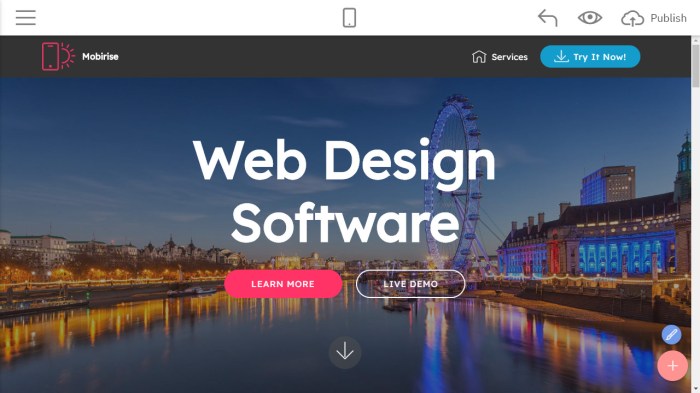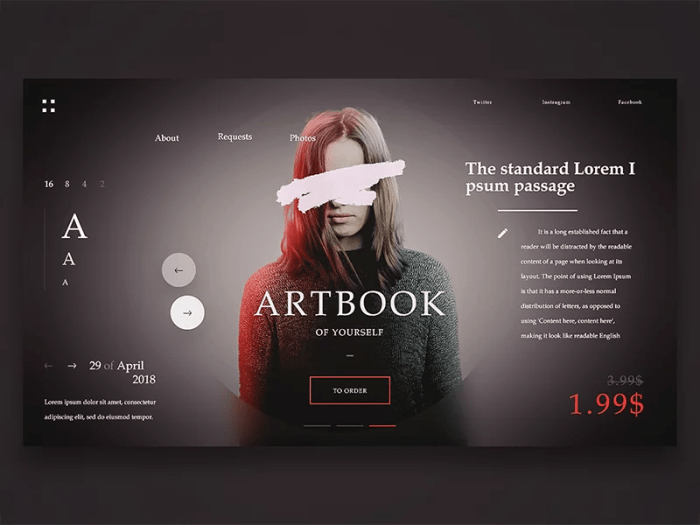Website Design Ideas takes center stage, inviting readers into a world of innovative concepts and cutting-edge trends. Get ready to dive into the realm of website design with style and flair.
From brainstorming unique ideas to incorporating interactive elements, this topic covers everything you need to know to create visually appealing and user-friendly websites.
Brainstorming Website Design Ideas
When it comes to brainstorming website design ideas, creativity is key. Here are some methods to help you generate unique concepts:
Research and Inspiration
- Start by researching current design trends and successful websites in your industry for inspiration.
- Look outside your industry for fresh ideas that you can adapt and incorporate into your own design.
- Visit design galleries and platforms like Behance, Dribbble, and Awwwards to see cutting-edge designs.
User Experience and Functionality
- Focus on creating a seamless user experience by designing intuitive navigation and clear call-to-action buttons.
- Ensure your website is mobile-responsive to cater to users accessing your site on different devices.
- Test your design to identify and eliminate any usability issues that may hinder user interaction.
Branding Elements
- Incorporate your brand colors, logo, and messaging consistently throughout your website to strengthen brand recognition.
- Create a unique visual identity that reflects your brand personality and values.
- Use custom graphics, typography, and photography to differentiate your website from competitors.
Visual Elements in Website Design

When it comes to website design, visual elements play a crucial role in catching the user’s attention and creating a memorable experience. Color schemes, typography, and imagery all work together to convey a brand’s message and identity, as well as guide the user through the site.
Color Schemes
Color schemes can evoke emotions and set the tone for a website. It’s important to choose colors that align with the brand’s identity and create a visually pleasing experience for users. Stick to a consistent color palette throughout the website to maintain brand recognition and ensure a cohesive look.
Typography
Typography is not just about choosing fonts, but also about creating hierarchy and readability. Use a combination of fonts for headings and body text to create visual interest and guide the user’s eye. Make sure the text is easy to read on all devices and screen sizes.
Imagery
Images and graphics can enhance the visual appeal of a website and help tell a story. Use high-quality images that are relevant to the content and align with the brand’s message. Consider using illustrations, icons, and videos to engage users and make the website more interactive.
Responsive Design, Website Design Ideas
Responsive design ensures that a website looks good and functions well on all devices, from desktops to smartphones. This is crucial for user interaction and engagement, as users expect a seamless experience regardless of the device they are using. Make sure visual elements adapt to different screen sizes and resolutions.
Consistency
Consistency in visual elements across a website helps establish a strong brand presence and creates a sense of professionalism. Ensure that color schemes, typography, and imagery are consistent on all pages to provide a cohesive and unified experience for users.
Navigation and User Interface Design: Website Design Ideas

In today’s digital age, designing intuitive website navigation and user interface is crucial for engaging visitors and ensuring a seamless browsing experience. Let’s explore some best practices and examples that can help elevate your website design.
Best Practices for Designing Intuitive Website Navigation
When it comes to website navigation, simplicity is key. Here are some best practices to keep in mind:
- Keep the navigation menu simple and easy to understand, with clear labels for each section.
- Use a logical hierarchy to organize content, making it easy for users to find what they’re looking for.
- Incorporate search functionality for users who prefer to search for specific content.
- Ensure that navigation is consistent across all pages of the website.
Examples of Effective User Interface Design
Effective user interface design can vary depending on the type of website. Here are some examples:
- An e-commerce website may have a prominent search bar, clear product categories, and easy-to-use filters for sorting products.
- A news website may have a clean layout with easy-to-read headlines, images, and related articles for seamless navigation.
- A portfolio website for a creative professional may showcase their work with visually appealing galleries and easy-to-access contact information.
Significance of Mobile-Friendly Navigation and User Interface
With the increasing use of mobile devices for browsing, it’s essential to prioritize mobile-friendly navigation and user interface design. Here’s why:
- Mobile users have limited screen space, so it’s important to optimize navigation for smaller screens.
- Responsive design ensures that your website adapts to different screen sizes, providing a seamless experience across devices.
- Mobile-friendly navigation enhances user experience and can improve your website’s performance.
Importance of Clear Call-to-Action Buttons in Website Design
Clear call-to-action buttons are essential for guiding users towards desired actions on your website. Here’s why they are important:
- CTA buttons help users understand what action to take next, whether it’s making a purchase, signing up for a newsletter, or contacting you.
- Well-designed CTA buttons with contrasting colors and compelling copy can increase conversion rates.
- Placing CTAs strategically throughout your website can improve user engagement and drive desired outcomes.
Incorporating Interactive Elements
To enhance user engagement on a website, incorporating interactive elements is crucial. These elements can range from animations and videos to interactive features that provide a dynamic and engaging user experience.
Interactive Elements for User Engagement
- Animations: Adding subtle animations to buttons, icons, or images can capture the user’s attention and guide them through the website.
- Videos: Incorporating relevant videos can help convey information in a more engaging way and keep users on the site longer.
- Interactive Features: Including interactive elements like quizzes, surveys, or interactive infographics can encourage user participation and make the website more memorable.
Tips for Integrating Interactive Elements
- Keep it Seamless: Ensure that interactive elements blend seamlessly with the overall design of the website to avoid a disjointed user experience.
- Focus on User Experience: Prioritize user experience when incorporating interactive elements to enhance engagement without overwhelming the user.
- Test Responsiveness: Make sure that interactive elements work well on different devices and screen sizes to provide a consistent experience.
Impact on User Experience and Retention
- Increased Engagement: Interactive elements can captivate users and encourage them to explore more content on the website.
- Improved Retention: Engaging features can make a lasting impression on users, increasing the likelihood of them returning to the site.
Balancing Interactive Elements with Loading Speed
- Optimize Performance: Minimize the file size of interactive elements to ensure fast loading times and a smooth user experience.
- Lazy Loading: Implement lazy loading for videos and images to prioritize content above the fold and improve loading speed.
